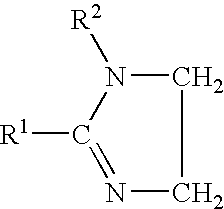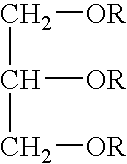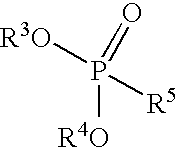Friction modifiers for slideway applications
a technology of friction modifiers and additive formulations, applied in the direction of liquid degasification, separation processes, group 5/15 element organic compounds, etc., can solve the problems that lubricant additives that are effective for metal surfaces may not be effective in reducing friction, and achieve similar friction-reducing properties and improve friction-reducing properties
- Summary
- Abstract
- Description
- Claims
- Application Information
AI Technical Summary
Benefits of technology
Problems solved by technology
Method used
Image
Examples
example 1
[0035]Boundary friction coefficients were measured using a PCS Instruments High Frequency Reciprocating Rig (HFRR). Friction coefficients were measured at 130° C. between a SAE 52100 metal ball and either a SAE 52100 metal disk or a 1 cm by 1 cm piece of plastic slideway material. The ball was oscillated across the materials at a frequency of 20 Hz over a 1 mm path, with an applied load of 4.0 N.
[0036]All fluids in Table I were blended into a Group II base oil with a 100° C. kinematic viscosity of ˜4.0 cSt. The friction modifiers, anti-wear / extreme pressure agents and detergents were added to the base oil at a concentration of 0.40 weight percent. The dispersants were added to the base oil at a concentration of 3.0 weight percent.
[0037]Table I shows the friction data for a series of fluids containing 1) a friction modifier, 2) an anti-wear / extreme pressure agent 3) a detergent and 4) a dispersant. The friction modifiers used in these fluids include: a metal-free, amine-containing fr...
example 2
[0041]In another series of tests, boundary friction coefficients were measured as in Example 1 at 130° C. between a SAE 52100 metal ball and a 1 cm by 1 cm piece of plastic slideway material. In test fluid contained a base oil having only 0.2 weight percent of each of the friction modifiers or anti-wear agents listed in example 1. The results are given in the following Table 3.
TABLE 3Weight percent130° C. Frictionin base oilAdditiveCoefficient on plastic0.20MoDTC0.2680.20ZDDP0.2020.20Thiadiazole0.1420.20GMO0.1060.20DMOP0.0940.20U—O0.072
[0042]According to the foregoing examples, the following observations may be articulated:[0043]1) metal-free friction modifiers (thiadiazole, GMO, DMOP and U-O) reduce friction on plastic better than metal-containing friction modifiers.[0044]2) amine-containing metal-free friction modifiers (U-O) reduce friction better than amine-free metal-free friction modifiers.[0045]3) metal- and sulfur-free phosphorus compounds (DMOP) reduce friction on plastic b...
PUM
| Property | Measurement | Unit |
|---|---|---|
| mass % | aaaaa | aaaaa |
| frequency | aaaaa | aaaaa |
| kinematic viscosity | aaaaa | aaaaa |
Abstract
Description
Claims
Application Information
 Login to View More
Login to View More - R&D
- Intellectual Property
- Life Sciences
- Materials
- Tech Scout
- Unparalleled Data Quality
- Higher Quality Content
- 60% Fewer Hallucinations
Browse by: Latest US Patents, China's latest patents, Technical Efficacy Thesaurus, Application Domain, Technology Topic, Popular Technical Reports.
© 2025 PatSnap. All rights reserved.Legal|Privacy policy|Modern Slavery Act Transparency Statement|Sitemap|About US| Contact US: help@patsnap.com



